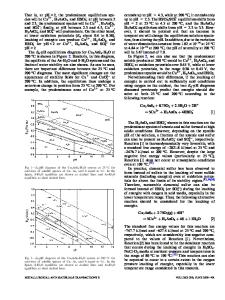Dissolution kinetics of synthetic LaPO 4 -monazite in acidic media
- PDF / 1,027,058 Bytes
- 5 Pages / 432 x 648 pts Page_size
- 102 Downloads / 302 Views
MRS Advances © 2018 Materials Research Society DOI: 10.1557/adv.2018.205
Dissolution kinetics of synthetic LaPO4-monazite in acidic media Yulia Arinicheva1, Stefan Neumeier1, Felix Brandt1, Dirk Bosbach1, Guido Deissmann1 Forschungszentrum Jülich GmbH, Institute of Energy and Climate Research – Nuclear Waste Management and Reactor Safety (IEK-6), 52425 Jülich, Germany 1
Single-phase monazite-type ceramics are discussed as waste forms for the safe disposal of surplus plutonium or separated minor actinides. To derive a fundamental understanding of the long-term stability of these materials under repository relevant conditions, the dissolution kinetics of synthetic lanthanum monazite (LaPO4) were studied in dynamic dissolution experiments in the temperature range from 50 to 90°C under acidic conditions. The surface area normalised dissolution rates increased with temperature from 3.2·10-5 g m-2 d-1 at 50°C to 1.8·10-4 g m-2 d-1 at 90°C. The apparent activation energy Ea of the dissolution process was determined to be about 44 kJ mol-1, indicating a predominantly surface reaction controlled dissolution process in this temperature range. From thermodynamic considerations it can be inferred that the dissolution of the LaPO4 ceramics is governed by the dissolution of a thin layer of La-rhabdophane (LaPO4 · 0.667H2O) forming at the monazite surface in low temperature aqueous environments.
Introduction In the last decades, various ceramic materials have been proposed as potential waste forms for the immobilization of special nuclear waste streams, such as separated plutonium from civilian or military sources, or separated minor actinides [1-5]. Among them, monazites (monoclinic LnPO4) appear as promising candidates due to their specific physico-chemical properties including high structural flexibility for actinide incorporation, high chemical durability, and high resistance against radiation induced amorphisation [6-11]. The aqueous durability of a nuclear waste form under post-closure conditions is a key issue with respect to its performance in the repository environment. So far rather few studies were dedicated to the dissolution kinetics of natural monazite [12] and synthetic rare earth phosphates with monazite structure [13-15], with only few of them addressing the temperature dependence of the dissolution rate [12, 13]. Here we report the results of dynamic dissolution experiments performed with synthetic LaPO4-monazite at far from equilibrium conditions to gain a deeper insight into mechanisms governing the dissolution of monazite-type ceramic waste forms and the temperature dependence of its dissolution kinetics.
Downloaded from https://www.cambridge.org/core. Access paid by the UCSB Libraries, on 21 Feb 2018 at 11:39:06, subject to the Cambridge Core terms of use, available at https://www.cambridge.org/core/terms. https://doi.org/10.1557/adv.2018.205
Materials and methods A hydrothermal wet-chemical route was employed for the synthesis of the LaPO4 precursor material using a slight modification of the approach
Data Loading...











